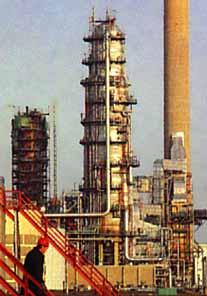Where does it come from?
Gasoline is derived from crude oil, a mixture of hydrocarbons of differing chain length that is pumped out of the ground from oil reserves as petroleum.
This difference in chain length is fundamental to the utilisation of crude oil since as the chain length increases, it is more likely that the chains will become more entangled hence increasing their viscosity (becomes less runny) and boiling point.
The crude oil can then be heated in a process known as fractional distillation which is carried out in an oil refinery. The shorter, lighter hydrocarbons (typically five to seven carbon atoms long) known as naphthas vaporise easily, these are typically used as solvents and dry cleaning fluids.
 An image
showing a fractional distillation column at an oil refinary
An image
showing a fractional distillation column at an oil refinary
The hydrocarbon chains containing seven through to eleven carbon atoms are merged together in order to form gasoline. Despite an increase in chain length, the boiling point is still lower than that of water which explains why petrol evaporates easily when it is spilt.
The next to follow in the distillation process is that of kerosene, diesel, lubricating oils and finally paraffin wax, tar and bitumen. The last few fractions have chains containing more than twenty carbon atoms and hence have extremely high boiling temperatures.